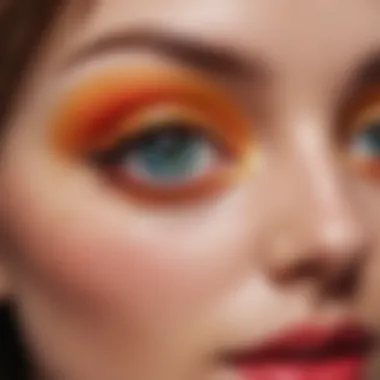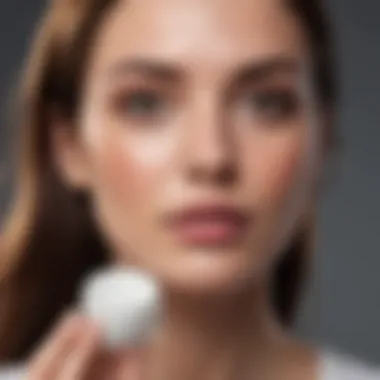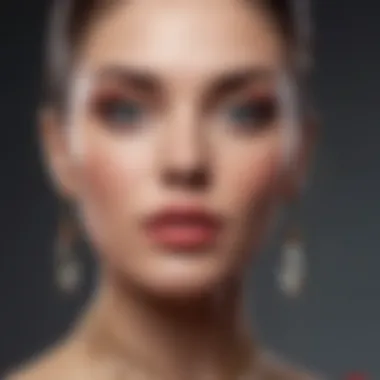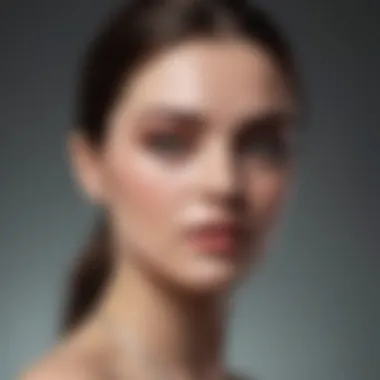The Quintessence of Beauty: An In-Depth Exploration


Intro
The subject of beauty remains a powerful and intricate topic. It is deeply embedded in the fabric of society, influencing how individuals perceive themselves and each other. This exploration aims to dissect the modern definitions of beauty, acknowledging the multifaceted nature of its existence. Beauty is not merely a visual or superficial trait; it encompasses ideals, narratives, and practices that evolve over time.
As societal standards evolve, so do the expectations placed upon individuals, particularly women. This article not only examines these shifts but also emphasizes the importance of authentic self-expression. It encourages readers to embrace their own definitions of beauty.
Tips and How-Tos
Skincare Routines for Different Skin Types
Understanding your skin type is crucial in establishing an effective skincare routine. The primary skin types include oily, dry, combination, and sensitive. Here are some tips tailored for each type:
- Oily Skin: Use a gentle foaming cleanser to avoid excessive oiliness. Lightweight, oil-free moisturizers are essential. Consider incorporating salicylic acid to minimize breakouts.
- Dry Skin: Choose a creamy, hydrating cleanser. Look for ingredients like hyaluronic acid and oils in your moisturizer to keep the skin nourished and supple.
- Combination Skin: Balance is key. Utilize a gentle cleanser that can address both oily and dry areas. Use specific treatments for combination skin, like lighter moisturizers during the day and richer ones at night.
- Sensitive Skin: Opt for fragrance-free and hypoallergenic products. Avoid harsh exfoliants and irritating ingredients, as they may trigger redness or rash.
Haircare and Styling Basics
Haircare is not one-size-fits-all. Identifying your hair type, whether it is straight, wavy, curly, or coily, is essential. Each type requires different products and techniques.
- For Straight Hair: Use lightweight shampoos and conditioners to avoid weighing down the hair. Heat protectants are valuable if you frequently style with heat.
- For Wavy Hair: Use leave-in conditioners or curl-defining creams to enhance waves and minimize frizz.
- For Curly Hair: Hydration is key. Opt for sulfate-free shampoos and deep conditioning treatments.
- For Coily Hair: Embrace moisture with rich creams and oils. Protective styles can help maintain health and reduce damage.
Sustainable Practices
Eco-Friendly Fashion Brands
In today's world, sustainability has become increasingly important in the fashion industry. Many brands now prioritize eco-friendly practices. Noteworthy brands include Patagonia and Eileen Fisher, which focus on responsible sourcing and fair labor practices. They strive to create beautiful pieces that do not harm the environment.
Tips for Sustainable Grooming
Sustainable grooming encompasses more than just fashion. Consider these practices:
- Opt for refillable or reusable containers for cosmetics and toiletries.
- Choose products made from natural or biodegradable ingredients.
- Research brands that support ethical practices and cruelty-free standards.
Celebrating Diversity in Beauty
Inclusive Beauty Brands
The perception of beauty is shifting towards inclusivity. Brands like Fenty Beauty have paved the way by offering a diverse range of products that cater to an array of skin tones. This shift signifies progress, promoting the idea that beauty is an expansive concept, not limited to a narrow ideal.
Cultural Influences on Fashion
Cultural influences play a significant role in shaping beauty standards. Different styles, colors, and aesthetics can be traced to specific traditions and histories. It is vital to recognize and appreciate these differences while fostering respect for the unique beauty that each culture brings. Beauty can be seen as both a personal and collective expression, enhancing the dialogue on what it means to be beautiful in today’s society.
"Beauty is varied, rich, and complex. It is not merely a reflection of physical appearance, but rather an intersection of history, culture, and personal identity."
Overall, this exploration emphasizes a holistic understanding of beauty. Through the insights and practices discussed, the aim is to empower women to find their voice in defining beauty. Embracing individuality is powerful.
Understanding Beauty
Understanding beauty is an essential aspect of comprehending the broader cultural and social implications of how beauty is perceived today. The foundations of beauty extend beyond mere aesthetics; they encompass historical narratives, cultural norms, and the psychological elements that influence individual self-image. Beauty is not just about outward appearances but also about what is accepted and admired in various contexts and eras.
Recognizing beauty's complexities helps in exploring its profound impact on individuals and societies. By dissecting the historical, cultural, and media-driven factors that shape beauty standards, we can better appreciate the diverse expressions of beauty that exist. This understanding fosters an environment that values authenticity and encourages women of all ages to embrace their unique identities.
Through the lens of beauty, we can assess its implications on mental health, confidence, and individuality. The discourse surrounding beauty invites a critical evaluation of how external pressures can affect personal and collective self-worth, ultimately, contributing to a healthier society where varied definitions of beauty are celebrated.
The Historical Context of Beauty


The historical context of beauty outlines how perceptions and ideals have shifted dramatically over centuries. Various civilizations have contributed unique standards, shaped by art, literature, and philosophical thought. In ancient Greece, the idea of beauty was intertwined with concepts of proportion and symmetry, as exemplified in their sculptures and architecture. The Renaissance further evolved these ideas, highlighting a return to naturalism and an appreciation of the human form.
Over time, these standards evolved and often reflected societal values and norms. For instance, the Victorian era idealized modesty and restraint, influencing women's fashion and behavior. In contrast, the 20th century brought an era of dramatic change, embracing different body types and styles influenced by economic and cultural transformations.
Understanding this historical context illuminates how past philosophies and standards influence contemporary beauty norms. It offers insight into the cyclical nature of beauty ideals, where trends may shift but often reflect underlying societal attitudes and beliefs.
Cultural Perspectives on Beauty
Cultural perspectives on beauty reveal a rich tapestry of interpretations that vary across different societies. What one culture considers beautiful may differ significantly from another, driven by historical, religious, and environmental factors. For instance, in many African cultures, body adornment and intricate hairstyles are a testament to beauty, reflecting identity, status, and heritage. Meanwhile, in Western societies, thinness and cosmetic enhancements often dominate beauty discussions.
This diversity highlights the value of cross-cultural appreciation and understanding. Embracing a range of beauty definitions allows individuals to see beauty as a multifaceted concept shaped by varied experiences and influences. It raises important questions about inclusivity and acceptance, encouraging women to explore and appreciate different cultural expressions of beauty.
Moreover, recognizing these cultural frameworks can empower women, as they engage with a broader understanding of beauty that transcends narrow definitions often propagated in mainstream media.
The Impact of Media on Beauty Standards
The media plays an undeniable role in shaping beauty standards across societies. From traditional advertising to social media platforms, images of beauty are often curated and filtered, creating a narrow lens through which beauty is viewed. This representation can lead to unrealistic expectations, pushing individuals, especially women, to conform to idealized standards.
Research shows that constant exposure to these media portrayals can affect self-esteem and body image. As a result, many women feel pressured to achieve standards that may be unattainable or unhealthy. The portrayal of beauty in media often reflects a homogenized ideal, ignoring the diversity of real women and thus perpetuating a limited view.
Yet, media also has the potential to transform. Many campaigns challenge harmful stereotypes and promote body positivity, showcasing real women with diverse body types and features. Activism within and outside of the media landscape encourages a new narrative that accepts beauty in all its forms.
Ultimately, understanding the media's role in shaping beauty standards helps individuals navigate their self-image and expect authenticity in representation. A conscientious approach can cultivate a more inclusive and empowering perspective on beauty.
Defining Modern Aesthetics
Defining modern aesthetics is crucial in understanding how beauty is perceived and experienced today. Aesthetics influences not only individual choices but also societal norms. The current generation engages with beauty diversey through various lenses. This includes culture, technology, and personal preference. This section will explore critical elements such as contemporary beauty trends, sustainable practices, and inclusive standards.
Contemporary Trends in Beauty
Contemporary trends shape the beauty landscape significantly. In recent years, there has been a shift towards more natural looks and clean beauty products. This reflects a desire for authenticity as consumers prioritize ingredients and efficacy. Trends such as minimal makeup and skincare routines gain popularity. Brands like Fenty Beauty and Glossier have reshaped beauty marketing by focusing on diversity and personal expression. This encourages women, across age and background, to embrace their unique features.
Moreover, digital platforms play a key role in defining and disseminating new trends. Social media is a primary source for beauty tips and inspiration. The rise of beauty influencers has created a more democratic approach to beauty, challenging traditional ideals.
Sustainable Beauty Practices
Sustainable beauty practices represent an emerging focus for many consumers. Today, environmental concerns are increasingly prioritized. Many brands adopt eco-friendly packaging and ethically sourced ingredients. This change supports a bigger movement towards responsible consumption.
Choosing sustainable products not only preserves the environment but resonates with consumers personally. Many young women see sustainability as essential to their identity. Brands like Lush and The Body Shop actively promote such values, reflecting a change in consumer expectations. This involves products that can reduce carbon footprints and environmental harm.
"Succeeding in beauty today means committing to sustainability. Every choice matters."
Inclusive Beauty Standards
Inclusive beauty standards are reshaping how beauty is defined. The conversation around inclusivity has become paramount. It is crucial to recognize that beauty varies widely and comes in many forms. No single standard should dominate the narrative. This has led to a broader representation in campaigns and media.
Brands now feature models of all skin tones, body sizes, and ages. The impact is profound on society, offering women the chance to feel seen and represented. Brands like Dove and CoverGirl have paved the way for inclusive definitions. They challenge the stereotypes that were predominant in the beauty industry.
Overall, modern aesthetics are about personal choice and representation. The conversation continues to evolve, inviting women to explore beauty authentically. Recognizing the significance of these trends helps clarify what constitutes beauty today.
Fashion and Beauty Interconnection
The relationship between fashion and beauty is intricate and profound. Both realms influence one another and shape perceptions of aesthetics in society. Fashion sets trends that beauty often follows, while makeup and skincare products help accentuate individual styles. This interconnection is crucial to understanding how beauty standards evolve in contemporary culture.
Moreover, both fashion and beauty play a significant role in self-expression. Through clothing choices and makeup application, individuals convey messages about their personalities, preferences, and identities. This symbiotic relationship enhances the notion of beauty, transforming it from a static concept to a dynamic form of personal and cultural expression.


The Role of Personal Style
Personal style is a vital component of the fashion-beauty relationship. It encompasses how individuals choose to present themselves daily. Everyone has a unique interpretation of style, influenced by lifestyle, culture, and personal experiences. A well-curated wardrobe can reflect individual tastes, while beauty practices further accentuate that uniqueness.
"Fashion and beauty work together to create a narrative around personal identity."
When individuals feel confident in their personal style, their beauty often shines through. On the other hand, certain beauty practices can encourage exploration and experimentation in style choices. Makeup brands, for instance, endorse products that enable users to enhance their features, thus complementing their outfits.
Access to Fashion Innovations
Access to fashion innovations is another critical aspect of this interconnection. With the rise of technology, many brands have started to create versatile fashion items that not only cater to style but also address beauty needs. For example, clothing with built-in beauty technologies is on the market. This includes fabrics that can improve skin health, such as those infused with skincare ingredients.
Online platforms have democratized fashion, giving access to diverse styles and beauty products. Social media has become a hotspot for discovering new trends and sharing personal interpretations of fashion and beauty, further blending these two domains and allowing for unique explorations.
Cosmetic Trends Influencing Fashion
Cosmetic trends exert a considerable influence on fashion choices. Certain makeup looks can dictate the popularity of specific fashion styles. For instance, a bold lip color can inspire vibrant outfits that draw attention to the face, while natural, fresh makeup might pair well with minimalist clothing.
Additionally, seasonal color palettes in the beauty industry often mirror those in fashion. This harmony ensures that both sectors remain aligned, maintaining their relevance in the ever-changing landscape of aesthetics.
Understanding the interconnection between fashion and beauty provides deeper insights into contemporary culture. Recognizing this link helps individuals appreciate how their choices in clothing and beauty products reflect their identities and aspirations.
Skincare as a Foundation of Beauty
Skincare plays a fundamental role in the overall concept of beauty. It is not merely about maintaining a polished exterior; it provides a sense of well-being and confidence. Skincare routines can influence how an individual feels about themselves, shaping their self-image and, in turn, their interaction with the world. Healthy skin represents vitality and reinforces the idea that beauty is deeply intertwined with health. When individuals invest time in their skincare, it promotes a positive relationship with their own bodies, fostering self-care practices that extend beyond mere aesthetics.
Choosing the Right Products
Selecting the right skincare products is essential for achieving desired results. It involves understanding one's specific skin type, whether oily, dry, or a combination. Different products cater to different needs. For instance, moisturizers, serums, and cleansers are tailored to nurture and protect the skin. One should not overlook the importance of ingredients. Natural ingredients, such as aloe vera, hyaluronic acid, and essential oils, can provide beneficial properties without harsh side effects. Moreover, it is advisable to read labels and be aware of potentially harmful additives.
"The skin is the body’s largest organ, and it deserves as much care as any other part of your body."
The Science Behind Skincare
Understanding the science of skincare is crucial for anyone looking to enhance their beauty regimen. The skin serves as a barrier that protects against environmental aggressors, aging, and damage. Each layer of the skin has specific functions, which means that product formulation must be appropriate for those layers. For example, products with active ingredients like retinol or vitamin C can penetrate deeper layers of the skin, promoting cellular turnover and enhancing skin texture. Knowledge of the absorption process can help individuals choose products that deliver the best results.
Holistic Approaches to Skincare
Embracing holistic approaches in skincare recognizes that true beauty begins from within. It is about merging physical care with mental and emotional health. This can include practices such as mindfulness, stress management techniques, and a balanced diet, which all contribute to radiant skin. Furthermore, using organic and eco-friendly products aligns with the philosophy of holistic beauty, advocating for both personal health and the environment. Using rituals, such as dedicated time for applying skincare products can also create a moment of self-affirmation, reinforcing the importance of feeling good about oneself.
Makeup as an Expression of Identity
Makeup serves as a powerful form of self-expression. It has the capability to transcend conventional beauty standards and becomes a tool for individuals, particularly women, to communicate their identity. In this rapidly changing social landscape, makeup is often much more than just a cosmetic application; it allows for experimentation and a personal narrative. People utilize makeup for various reasons that align with their self-image, cultural background, and emotional states.
Exploring Different Makeup Techniques
Different techniques in makeup can alter perceptions and meanings. For example, contouring reshapes the face to create a desired aesthetic, while bold colors can express vibrancy or confidence. Each technique tells a story. The choice of foundation, for instance, can reflect a desire for natural beauty or a polished appearance, depending on the individual’s background and personal style.
Some popular techniques include:
- Strobing: Highlighting skin to create a dewy glow.
- Cut Crease: Defining eyes to emphasize their shape.
- Graphic Liner: Using eyeliner in artistic ways for bold expressions.
These techniques can empower individuals to showcase their creativity and personal style, presenting various facets of their identity.
Cultural Significance of Makeup
Makeup carries significant cultural weight across various societies. Different cultures embrace distinct beauty ideals linked to their values and traditions. In some cultures, specific makeup styles may hold historic significance or be tied to rituals. For example, the use of kohl in Middle Eastern cultures not only enhances beauty but has cultural and religious importance.
Understanding these cultures enriches the conversation around makeup as a canvas for identity. It emphasizes the need for awareness and respect for diverse beauty practices. Indeed, the increasing globalization leads to a cross-pollination of these practices, encouraging a broader acceptance of varied beauty standards.
The Role of Makeup in Empowerment


Makeup can have profound impacts on empowerment. It allows individuals to control their appearance, aiding in boosting self-confidence. When people engage with beauty products, it can lead to positive self-image and a sense of agency over how they present themselves to the world.
- Confidence Boost: Applying makeup can transform how one feels about their appearance, contributing to an enhanced self-esteem.
- Creative Outlet: Makeup encourages creativity, allowing individuals to express their feelings or moods through color and technique.
- Community Building: Engaging with others who share an interest in makeup can create a sense of belonging and kinship.
Makeup can indeed serve as a bridge to empowerment, providing a platform for individual expression and collective identity, making it a vital aspect of contemporary culture.
Psychological Aspects of Beauty
The realm of beauty is not just skin-deep; it goes much deeper, intertwining with our psychological framework. Understanding the psychological aspects of beauty is crucial in exploring how beauty standards influence self-perception, peer interactions, and mental well-being. This section will navigate through the complexities surrounding beauty in relation to personal identity, societal expectations, and emotional health.
Self-Image and Beauty Standards
Self-image plays a significant role in how individuals perceive themselves in the context of beauty. Beauty standards set by society often dictate what is considered attractive. These standards can be established through various channels—media, cultural norms, and historical perspectives. Consequently, many people internalize these criteria, shaping their self-esteem and confidence levels.
The pressure to conform to an idealized beauty can lead to dissatisfaction and a distorted self-image. For instance, individuals who do not match societal expectations may experience feelings of inadequacy. This mismatch highlights the need for relativity in beauty norms. It’s essential to promote diverse representations of beauty that encompass a spectrum of shapes, colors, and features.
“The greatest beauty is the beauty of diverse identities united by individual expression.”
The Influence of Peer Perception
Peer perception significantly influences how beauty is experienced and conceptualized. The perspectives of friends, family, and social networks leave a deep imprint on one's feelings about their beauty. Often, some behaviors, such as validation through likes or compliments, are tied too much to external approval. This can lead to a continuous cycle where individuals seek constant affirmation from their peers rather than fostering a genuine self-acceptance.
In essence, the impact of peers can lead to both positive and detrimental effects on an individual’s self-worth. Supportive peers can enhance confidence, whereas critical remarks can reduce self-esteem. Thus, understanding this dynamic is crucial, especially in educational settings and social arenas where young people learn about beauty and self-worth.
Beauty and Mental Health
The intersection of beauty and mental health is particularly poignant. Perceptions of beauty can directly affect mental health outcomes. Discrepancies between personal self-image and societal beauty standards can contribute to conditions like anxiety, depression, and even eating disorders.
Conversely, promoting a healthier understanding of beauty can be empowering. Educational programs that emphasize self-love, body positivity, and mental well-being can create more resilient individuals. Encouraging dialogues about mental health alongside beauty standards integrates two crucial aspects of human experience, leading to a more holistic approach to beauty comprehension.
It is also important to recognize how engaging in beauty practices can affect mental health. Activities like skincare routines or makeup application can serve as forms of self-care. However, they should not become obligatory or serve as a metric of worth. The key is balance.
By fostering an understanding of the psychological impact surrounding beauty, society can work towards more inclusive narratives that embrace individual differences and promote mental health. This understanding is essential for empowering women of all ages to navigate their unique experiences with beauty in today's complicated landscape.
The Future of Beauty
Understanding the future of beauty is crucial as it reflects evolving societal norms, consumer behaviors, and technological advancements. This section unpacks how modern beauty standards may transform in the coming years. It delves into the impact of technology, the rise of influencers, and predictions about where beauty norms are headed. Each of these factors is interconnected and plays a significant role in shaping the future landscape of beauty.
Technological Innovations in Beauty
The beauty industry is undergoing rapid changes due to technological innovations. From virtual try-on apps to personalized skincare solutions, technology is revolutionizing how consumers interact with beauty products.
- Virtual Reality and Augmented Reality: With tools like L'Oreal's Virtual Makeup App, customers can see how makeup looks on their own faces before making a purchase. This not only enhances the shopping experience but also reduces wastage.
- AI in Personalization: Companies are using artificial intelligence to examine individual skin conditions and recommend suitable products. For example, Proven Skin Care uses AI to create personalized skincare regimens based on data from skin assessments.
- Sustainable Technology: As sustainability becomes more important, brands are leveraging technology to create eco-friendly packaging and production methods. For instance, brands like Loop Beauty focus on eliminating single-use plastics in their products.
These innovations make beauty more accessible and tailored, making it easier for individuals to express themselves authentically.
The Role of Influencers
Social media influencers have changed the beauty landscape significantly. They play a pivotal role in shaping beauty standards and consumer choices. Influencers connect with consumers on a personal level, making beauty products more relatable.
- Impact on Trends: When influencers endorse products, they often set trends that resonate with their followers. For example, makeup tutorials on platforms like Instagram and TikTok can launch products overnight.
- Diverse Representation: Many influencers are advocating for diversity and inclusivity in beauty. They are pushing brands to reconsider conventional beauty norms.
- Consumer Trust: By sharing personal experiences and reviews, influencers create a sense of trust. This engagement encourages their audience to explore new products and brands.
In essence, influencers not only market products but also shape how beauty is perceived.
Predictions for Beauty Norms
Looking ahead, several predictions stand out in understanding future beauty norms. These predictions stem from current trends in consumer behavior, technological development, and cultural shifts.
- Emphasis on Authenticity: The future may see a stronger push towards authenticity in beauty. Consumers are increasingly valuing real experiences over curated perfection.
- Continuing Inclusivity: The shift towards inclusivity will deepen. Brands that embrace diversity will likely gain a competitive advantage.
- Holistic Beauty: There may be a growing acceptance of holistic approaches to beauty that integrate wellness and mental health. This trend acknowledges the connection between inner and outer beauty, reflecting a more well-rounded view of what it means to be beautiful.
"The evolution of beauty standards reflects a deeper understanding of individuality and self-acceptance."
Understanding these components is vital for women of all ages as they navigate the complex landscape of beauty. It encourages them to embrace technology and authenticity while fostering deeper connections with their personal definitions of beauty.







